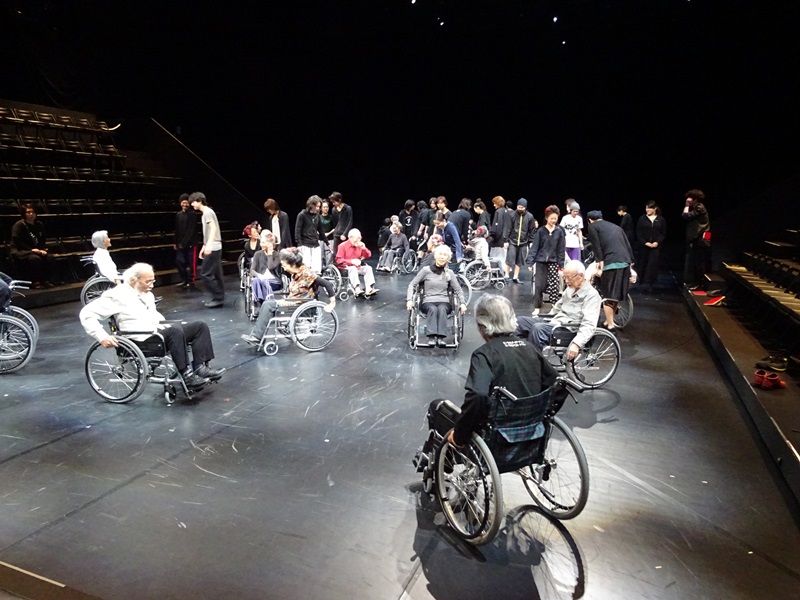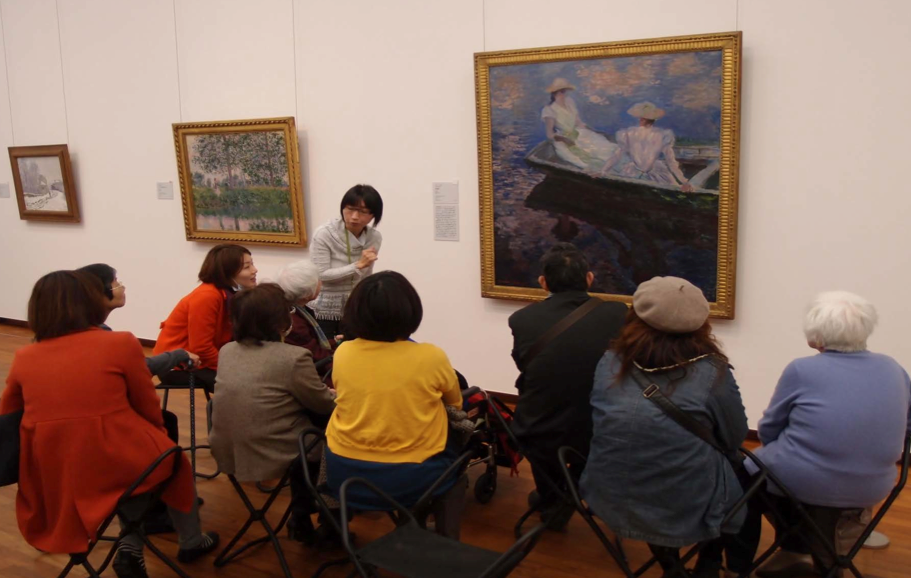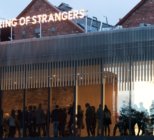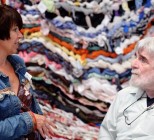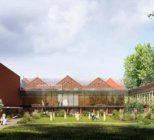It’s sometimes good to get out, escape the day-to-day and reflect on and share what you do and how and why. Recently, I had the privilege of being able to do this in spades. I was invited by the British Council, Baring Foundation and Gulbenkian Foundation, to join a week-long study tour in Japan focused on arts and ageing. Leaders and practitioners were invited from across a range of UK organisations committed to working on arts and ageing including Sadler’s Wells, West Yorkshire Playhouse, Luminate Festival, Equal Arts, Entelechy Arts, Wigmore Hall, Manchester Camerata, National Museums Liverpool and Arts for Health Cornwall and Isles of Scilly. This was an extraordinary opportunity to spend a week thinking about arts and ageing, share insights and explore how other organisations and cultures approach and develop this work.
Arts and ageing has become an increasingly important part of our work. At the Whitworth, we are about to launch A Handbook for Cultural Engagement with Older Men, a collection exhibition Danger! Men at Work (images of masculinity and ageing) and recruit a new Age Friendly Manchester Cultural Coordinator to work with Culture Champions (150 citywide older volunteers) whilst at Manchester Museum, we’re soon to recruit an Age Friendly Volunteer Assistant to support socially isolated older volunteers as part of our Inspiring Futures programme.
Why Japan?
But why Japan? The numbers tell quite a story with 25 per cent of the population in Japan is over 65 (in the UK, we will reach a similar point by 2050). Older people are physically healthier than ever before, but there is a high rate of dementia: an estimated 4.6 million, based on a recent small-scale quantitative study. As well as a demographic (and economic) imperative, 2020 will see Tokyo hosting the Olympics. This brings an impetus, focus and opportunity for sectors to work more closely and the arts to play a larger part in society as they seek to revitalise not only Tokyo but also the regions through culture and are looking to London 2012 as a model of cultural innovation and legacy-building.
So, the British Council organised a packed and fascinating few days, with several public forum events, workshops and visits that enabled us to share our work, projects and plans as well as learn more about arts and ageing in Japan. I’ve been back over a fortnight now and the things that stick in my mind are the conversations, stories and insights as well as the moments or notes of cultural difference. Here are a few.
Lifewide
One of the academics from the LIFE Center at Tokyo University spoke of how they seek to develop work which is not only lifelong but lifewide. I love this and intend to repeatedly use this phrase – its sums up beautifully my aspirations for museums. It is also exactly what we encountered in Saitama Arts Theatre in Tokyo, where we observed a rehearsal and met with members of Saitama Gold Theater. We learnt more about how this extraordinary group was developed by Yukio Ninagawa, one of Japan’s most significant theatre directors.
Saitama Gold Theater was founded in 2006 out of Ninagawa’s desire to search for a new form of theatre based on people’s personal histories and experience of age. “Old age is proof that you experienced deep emotions and many days of ordinary lives. Physical expression using this personal history might help one to discover one’s new prospective,” said Ninagawa.
Ninagawa spent two weeks auditioning over 1,200 people (over 55) from all across Japan and selected 48 members between the ages of 55 and 80. These members gather for four hours a day, five days a week for training and instruction from Ninagawa and his team. I’d read that Japan respects harmony more readily than individual performance or expression, yet Saitama Gold Theater readily embraced both. What really struck me was the joy, ‘will’ and purpose of the members of Gold Theater matched by the rigour, commitment and artistic excellence of their work.
Throughout the visit, I noticed an enviable interest from and engagement with the business sector. At a public forum on dementia friendly communities, over half of the audience were from industry or business. Held in conjunction with the Dementia Friendly Japan initiative (a loose network of those with dementia, their families, NPOs, business, and researchers) this dialogue session explored how to include the arts in building a dementia friendly society. In the wonderful setting of 3331 Arts Chiyoda, a renovated high school that is now home and creative exchange/hub for artists and communities, we heard from a business leader alongside a speaker living with dementia. We listened to conversations about Japanese working culture, retirement and how, when you have spent much of your life focused on work and committed to one skill or discipline, do you start to try new things (museums, arts) and enjoy retirement and the choices it brings?
Free social spaces
In museums and galleries, there are quite significant differences between Japan and the UK. The level of cross-sector partnerships is far more developed in the UK, as is the sense that museums are free social spaces that bring people together. In Japan, there is more focus on projects and exhibitions. However, we were introduced to some great artist-led work, often developed with limited coordination or connection to bigger venues. Artist Yumiko Fujiwara spoke eloquently of her work in care settings with those at the end of life. She talked of how people face death, how senses sharpen and when words disappear, music, singing and physical forms of creative expression remain. She talked openly and movingly of the value to patients and their families of these final creative acts. I am struck by how, for many of us, this remains a last taboo and there are few dedicated programmes or work exploring creativity and end of life care.
Yoko Hayashi, Founder and Director of Arts Alive, observed how in Japan the aim is for everyone to enjoy making something attractive together under the direction of a professional artist, whereas in the West, the emphasis is on self-expression. She has dedicated her professional life to changing this.
Inspired by an arts for health symposium in Manchester in the late ’90s, Yoko has since focused on Art Communication and creative ageing projects and research and linked to MOMA’s Meet Me programme for people with dementia. Yet, many of the museums Arts Alive is working with still do not allow you to bring in chairs and people have complained about noise levels with this work. There is clearly some way to go. Yet, in spite of these differences, her conclusion resonated with many of the UK delegates with one saying: “Even if there is cognitive decline, creativity endures. We just need to convince others of the value of this.”
One museum that is leading the way in Japan is the Kitanagoya-shi Historical Museum. This museum dedicated to recreating everyday scenes of life in the Showa Era (1926-1989) and encourages visitors of all ages to talk to each other about the exhibits. In collaboration with an old house in the city, the museum has also created the Kitanagoya Reminiscence Centre, a registered National Treasure. This has been done in collaboration with the Ministry of Health and Welfare. They hold a weekly Reminiscence School, attended by older people and their Reminscence Kits (currently with three month waiting lists) travel across Japan.
Prevention
These ‘prevention’ and reminiscence development programmes are not for care, but daily life. Many speakers reflected on the intergenerational challenge facing Japan; the lack of engagement across generations and sense of burden amongst many older people. Museums like this create valuable spaces and reasons for communities to come together and explore different, creative forms of age exchange.
A public forum at the impressively huge National Arts Centre brought together over 100 people to consider the possible role of the arts in an ageing society using the “future” methodology of deciding upon the desired results and then “backcasting”. So, what are the collective aspirations for the future of arts and ageing in Japan? Perhaps not so different from our own. They include the ability to live as one wishes to and to accept others, the desire for a sense of unity and more communication between generations, more joy and cultural spaces that bring people together. As one participant summarised, “Society isn’t comfortable with those living at 90 yet. There may be no money and no cultural policy but the desire to dance, sing and create is our greatest strength” Wise and moving words, wherever you live.


